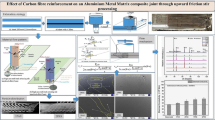Abstract
The existence of relatively high protrusions above the sheets on most of the clinched joints could sometimes bring about an undesired result in the subsequent processing and, therefore, the application of the clinching technologies might be restricted. The current study proposed a countermeasure by imposing compression on the joints with a pair of contoured tools and then obtaining a controlled local plastic deformation of the joints, resulting in a reduction of the protrusion height. A typical two-layer clinching of 6063 aluminum alloy sheets with the thickness of 0.8 mm was employed to study the successional processes of clinching, reshaping, and separation. Geometrical parameters of the reshaping tools were optimized in terms of pull-out strength on the basis of numerical simulation and orthogonal design. It was found that diameter d of the truncated cone end on the reshaping die, inclination α of the truncated cone, and then fillets of the die and punch are of important influence on the connecting strength. Moreover, connecting strengths of the clinched joints before reshaping and after reshaped with the optimal parameters of the tools were compared experimentally. The results show that the protrusion height of the clinched joints can be reduced dramatically by the method without decreasing the connecting strength. In the example, the protrusion height of the clinched joint decreased from 1.7 to 0.68 mm, while the average pull-out strength of the joints increased from 230.8 to 331.4 N, and the shear strength increased from 559.7 to 657.5 N.
Similar content being viewed by others
References
Neugebauer R, Todtermuschke M, Mauermann R, Riedel F (2008) Overview on the state of development and the application potential of dieless mechanical joining processes. Arch Civ Mech Eng 8(4):51–60
Varis JP, Lepisto J (2003) A simple testing-based procedure and simulation of the clinching process using finite element analysis for establishing clinching parameters. Thin-Walled Struct 41(8):691–709
Saberi S, Enzinger N, Vallant R, Cerjak H, Hinterdorfer J, Rauch R (2008) Influence of plastic anisotropy on the mechanical behavior of clinched joint of different coated thin steel sheets. Int J Mater Form 1(s1):273–276
Lee CJ, Kim JY, Lee SK, Ko DC, Kim BM (2010) Design of mechanical clinching tools for joining of aluminium alloy sheets. Mater Des 31(4):1854–1861
Mori K, Abe Y, Kato T (2012) Mechanism of superiority of fatigue strength for aluminium alloy sheets joined by mechanical clinching and self-pierce riveting. J Mater Process Technol 212(9):1900–1905
He XC (2010) Recent development in finite element analysis of clinched joints. Int J Adv Manuf Technol 48(5–8):607–612
De Paula AA, Aguilar MTP, Pertence AEM, Cetlin PR (2007) Finite element simulations of the clinch joining of metallic sheets. J Mater Process Technol 182(1–3):352–357
Coppieters S, Cooreman S, Lava P, Sol H, Van Houtte P, Debruyne D (2011) Reproducing the experimental pull-out and shear strength of clinched sheet metal connections using FEA. Int J Mater Form 4(4):429–440
Neugebauer R, Mauermann R, Dietrich S, Kraus C (2007) A new technology for the joining by forming of magnesium alloys. Prod Eng Res Devel 1(1):65–70
Busse S, Merklein M, Roll K, Ruther M, Zurn M (2010) Development of a mechanical joining process for automotive body-in-white production. Int J Mater Form 3(s1):1059–1062
Coppieters S, Lava P, Baes S, Sol H, Van Houtte P, Debruyne D (2012) Analytical method to predict the pull-out strength of clinched connections. Thin-Walled Struct 52(3):42–52
Oudjene M, Ben-Ayed L, Delameziere A, Batoz JL (2009) Shape optimization of clinching tools using the response surface methodology with moving least-square approximation. J Mater Process Technol 209(1):289–296
Author information
Authors and Affiliations
Corresponding author
Rights and permissions
About this article
Cite this article
Wen, T., Wang, H., Yang, C. et al. On a reshaping method of clinched joints to reduce the protrusion height. Int J Adv Manuf Technol 71, 1709–1715 (2014). https://doi.org/10.1007/s00170-014-5612-2
Received:
Accepted:
Published:
Issue Date:
DOI: https://doi.org/10.1007/s00170-014-5612-2




